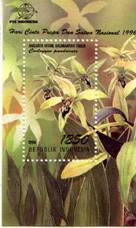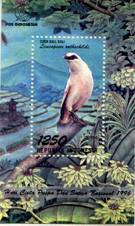Since 1993, in observance of the National Love Flora and Fauna Day, a series of stamps has been issued every year on 5 November depicting flora and fauna from the provinces of Indonesia. In year 1996 the series represents the flora and fauna of the Provinces of Bengkulu, Central Java, Bali, East Kalimantan and South Sulawesi.
- Giant Aroid Lily
(Amorphophallus Titanum)
This rare plant flowers only once every three years. Its giant flowering spike grows raidly to a height of two metres. The tallest bloom recorded for the species is 3,3 metres. The flower gives off a foul stench that attracts flies and beetles. This impressive Amorphophallus was first found in Western Sumatra by the Italian explorer-naturalist Odoardo Beccari in the 1880s, sixty years after Sir Thomas Stamford Raffles and Dr. Joseph Arnold discovered Rafflesia Arnoldi in the same region.
- Sun Bear (Helarctos
Malayanus)
Is the only bear living in Indonesia and the smallest of the world's bears. It is found in forests from Burma and Thailand through to Kalimantan and Sumatra. It has black fur with a distinctive white triangle, marking "V" on its chest. Although its body is relatively small, 1,10 to 1,40 m in length and 22 to 65 kg in weight, the Sun Bear is among the most feared of the forest animals. Since this bear is short-sighted, it may suddenly come across a person at very close quarters and be startled. When surprised, it will rise up on its hind legs and slash out in a panic with its vicious, long, sharp claws. Even the cubs can be dangerous, the Sun Bear is an omnivore; it eats fruit, succulent buds, insects and other invertebrates. But above all, it loves honey. It can climb tall trees to reach bees, nests and feasts on the sweet contents.


- Michelia (Michelia
Alba)
Has been known for a long time by the local people and used for various purposes, such as magic, ritual, religious as well as common ceremonies. The plant come from India and is presumed to have entered Indonesia in the 6th~7th century, the time when Hinduism came into the country. The plants are scattered in Sumatra, Java, Bali, Nusa Tenggara and Maluku. Every place has its own name for the plant, such as Jeumpa Gadeng (Aceh), Campaka Putiah (West Sumatra), Campala (Madura), Campaka Bodas (West Java), Campala Mariri (Minahasa), Bunga Eja (Makassar), Kupa Hanya (Seram), and nationally it's known as Cempaka Putih (White Champac). The plant can grow to 30~40 m high with a trunk of 1,5 m in diameter. It has a dense oval crown of dark shiny leaves. The plant flowers the whole year, mostly in rainy season.
- Golden Orioles (Orioles
Chinensis)
Are found in several places in Indonesia. This bird has golden yellow feathers and black stripes around the eyes and neck. The black stripes also decorate its wings and tail. Its beak and legs are pink. This symbol of Central Java eats small fruits and insects.


- Majegau (Dysoxylum
Densiflorum)
Bali is wellknown for its wood carving. One of the woods used by Balinese artists for carving is Majegau. This wood is hard, beautiful-colored and resistant to water or soil. Considering its role in the life of the Balinese symbol. Accordingly, efforts have been carried out to perserve and plant the wood to avoid extention due to the opening of forest for occupation. - Bali Starling (Leucpsar
Rothschildi)
This rare starling is unique to Bali. It is the only species of bird endemic to Bali and one of the most critically threatened birds in Indonesia. Nowadays the bird can only be found in Bali Barat National Park. Its population is only about 20~30, but in 1984 there were 254 birds. Starling ore singing birds, have slender beaks, white feathers with long crests, bare blue skin around the eyes and black tips to the wings and tail. When they sing, their crests rise and resemble thorns.


- Black Orchid (Coelogyne
Panduratalindi)
Indonesia is widely known for its numerous orchids. However the Black Orchid (Coelogyne Panduratalindi) of East Kalimantan Province is extremely rare. The orchid has pale green flowers with black dots in the middle. It has a flattened pseudobulb and each pseudobulb has two wide long leaves. The black orchid grows on shrubs and blossoms between April and December. In addition to its rareness, the flower doesn't last long. - Dolphin (Orcaella
Brevirostris)
Mainly live in the sea and only a few species live in the river. One of the river species is the Pesut Mahakam or Mahakam Freshwater Dolphin (Orcaella Brevirostris) also known as the Irrawady Dolphin, and is found in the Mahakam River, hundreds of kilometers from the sea. Different from other dolphins whose heads have bottlenosed shape, the Pesut has a bulbous head. It grows to about 2 metres long and 100 kg in weight. Living in heavily silted water, it doesn't rely on its tiny eyes to detect and avoid obstacles. Instead, it uses sonar echolocations to move through the muddy, sediment filled water. It is becomes the symbol of East Kalimantan because of its uniqueness.


- Lontar Palm (Borassus
Flabellifer)
Has a prominent place in Indonesian history because old manuscripts of ancient Indonesia were written on lontar leaves, until the Portuguese introduced paper to the region. Nowadays, the lontar plant has many uses, including a source of sugar which is obtained by cutting and bruising the big flower stalk. The fruits are like small black coconuts with sweet flesh inside. It is conspicuous by its crown of blue-green fan-shaped leaves. This palm can be found throughout South-east Asia, Africa, India, Indochina and Australia. In Indonesia it grows mainly in The Lesser Sundas, but it is South Sulawesi Province who adopts the plant for its symbol. - Sulawesi Hornbill
(Rhyticeros Cassidix)
Of 13 species of hornbills found in Indonesia, two live in Sulawesi. Of these two the brightly colored red-knobbed Sulawesi Hornbill is the larger one. It has a yellow neck and beak with green bare skin on its gizzard. The feathers are black but the tail is white. This Hornbill lays her eggs in a nesthole in a hollow tree. The bird is also known locally as burung tahun (the year bird) because the numbers of ridges on its beak are said to correspond to its age.



